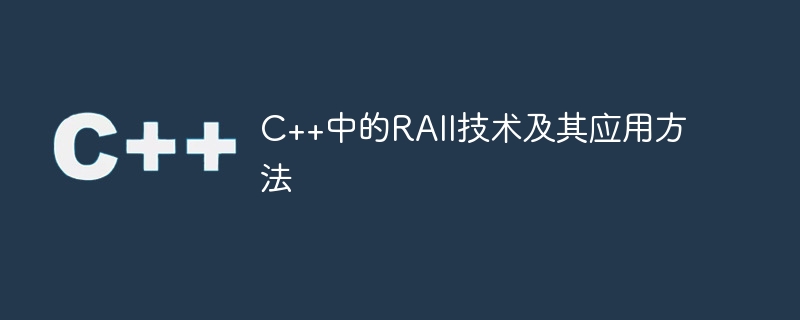

RAII refers to Resource Acquisition Is Initialization, that is, resource acquisition is initialization. It is a C programming technology that can automatically manage the allocation and release of resources, avoiding the cumbersome process of manual resource management by programmers, avoiding the risk of resource leakage, and also improving the readability and robustness of the program.
RAII technology is mainly implemented through C's constructor and destructor. When a C object is constructed, the constructor will be automatically called. At this time, resources can be applied for and initialized in the constructor. When the object is destroyed, the destructor will be automatically called. At this time, resources can be allocated in the destructor. of release. The core idea of RAII technology is that the life cycle of resources should be the same as the life cycle of objects, that is, resource application and release should be completed during object construction and destruction to ensure the correct management of resources.
RAII technology has a wide range of applications in practical applications. Below we use a specific example to illustrate it.
Suppose we have a resource management class that encapsulates an operation of opening a file. The file is opened in the constructor and closed in the destructor. The code is as follows:
class File
{
public:
File(const char* filename)
{
m_file = fopen(filename, "r");
if (!m_file)
{
throw std::runtime_error("Failed to open file");
}
}
~File()
{
if (m_file)
{
fclose(m_file);
}
}
void readData()
{
// 读取文件数据
}
void writeData()
{
// 写入文件数据
}
private:
FILE* m_file;
};The code using this class is as follows:
void processData(const char* filename)
{
File file(filename);
file.readData();
// 处理文件数据
}In the above code, we use RAII technology. When the File object is created, it will open the file and Automatically close files when the program ends, eliminating the need to manually manage the opening and closing of files. This can effectively avoid the risk of resource leaks and program crashes caused by forgetting to close the file.
In addition to files, RAII technology can also be used to manage other types of resources, such as memory, network connections, threads, etc. Below we take memory management as an example to show how to use RAII technology.
Suppose we have a class Memory that dynamically allocates memory, which encapsulates new and delete operations, allocates memory in the constructor, and releases the memory in the destructor. The code is as follows:
class Memory
{
public:
Memory(size_t size) : m_size(size)
{
m_data = new char[size];
}
~Memory()
{
delete[] m_data;
}
char* getData() const
{
return m_data;
}
size_t getSize() const
{
return m_size;
}
private:
char* m_data;
size_t m_size;
};The code using this class is as follows:
void processData(size_t size)
{
Memory memory(size);
// 使用内存
char* data = memory.getData();
// 处理内存数据
}In the above code, when the Memory object is created, it will allocate a memory of size size and use it in the program The memory is automatically released at the end, eliminating the need to manually manage memory allocation and release. This can effectively avoid the risk of memory leaks and program crashes caused by forgetting to release memory.
To sum up, RAII technology is a C programming technology that can automatically manage the allocation and release of resources, avoiding the cumbersome process of manual resource management by programmers, avoiding the risk of resource leakage, and also can Improve program readability and robustness. The core idea of RAII technology is that the life cycle of resources should be the same as the life cycle of objects, that is, resource application and release should be completed during object construction and destruction to ensure the correct management of resources. RAII technology has a wide range of applications in practical applications, such as the management of files, memory, network connections, threads and other resources, and can help us write reliable and robust programs.
The above is the detailed content of RAII technology and its application methods in C++. For more information, please follow other related articles on the PHP Chinese website!
 What are the differences between c++ and c language
What are the differences between c++ and c language
 Recommended learning order for c++ and python
Recommended learning order for c++ and python
 Cost-effectiveness analysis of learning python and c++
Cost-effectiveness analysis of learning python and c++
 Is c language the same as c++?
Is c language the same as c++?
 Which is better to learn first, c language or c++?
Which is better to learn first, c language or c++?
 The difference and connection between c language and c++
The difference and connection between c language and c++
 C++ software Chinese change tutorial
C++ software Chinese change tutorial
 Cost-effectiveness analysis of learning python, java and c++
Cost-effectiveness analysis of learning python, java and c++




